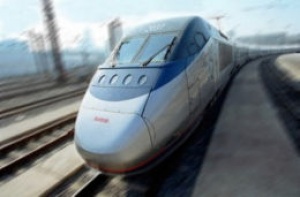US seizes high speed rail initiative

WHILE Britain awaits a further report on whether to go ahead with a second high speed rail line, US President Barack Obama has announced a strategic plan for 10 high-speed corridors — with up to $13 billion (£8.8 billion) to seed planning and development.
The President said America could not let itself be shunted to the side while other countries invested in modern transportation systems. “High-speed rail is long-overdue, and this plan lets American travellers know that they are not doomed to a future of long lines at the airports or jammed cars on the highways,” he said.
“What we need, then, is a smart transportation system equal to the needs of the 21st century,” he added, “a system that reduces travel times and increases mobility, a system that reduces congestion and boosts productivity, a system that reduces destructive emissions and creates jobs.”
$8 billion (£5.4 billion) in Mr Obama’s recently-announced economic rescue plan is allocated for investment in rail travel and must be spent over the next two years. He has asked for another $5bn in his budget to be spent on rail over the next five years, bringing the total to $13 billion (£8.8 billion) “as a down payment to jump-start a potential world-class passenger rail system and set the direction of transportation policy for the future.”
He added: “A major new high-speed rail line will generate many thousands of construction jobs over several years, as well as permanent jobs for rail employees and increased economic activity in the destinations these trains serve.”
ADVERTISEMENT
$13 billion is equivalent to what Britain has spent in the last ten years on modernising the West Coast Main Line.
America’s equivalent of the WCML is the North East Corridor, between Washington DC, Philadelphia, New York ands Boston, which has been upgraded in parts for 150 mph Acela trains, operated by Amtrak and based on TGV technology. But on many sections speeds are heavily reduced because of the nature of the route and the state of the track, and average speeds are generally below 80 mph.
Mr Obama said there was a possibility for the Northeast Corridor to compete for money to improve its existing high-speed service. America’s Federal Railroad Administration defines high-speed rail as any train traveling 90 mph or faster.
The US Department of Transportation said the Obama strategic plan will be followed by detailed guidance for state and local applicants. “By late summer, the Federal Railroad Administration will begin awarding the first round of grants,” adding: “Additional funding for long-term planning and development is expected from legislation authorising federal surface transportation programs.”
“President Obama’s vision of robust, high-speed rail service offers Americans the
kind of travel options that throughout our history have contributed to economic growth and enhanced quality of life,” said Transport Secretary Ray LaHood. “We simply can’t build the economy of the future on the transportation networks of the past.”
President Obama’s plans call for high-speed networks, 100 to 600 miles in length, in 10 corridors:
• California: San Francisco Bay Area, Sacramento, Los Angeles, San Diego?
• Pacific Northwest: Eugene, Portland, Tacoma, Seattle, Vancouver, B.C.?
• South Central: Tulsa, Oklahoma City, Dallas/Fort Worth, Austin, San Antonio, Little Rock?
• Gulf Coast Corridor: Houston, New Orleans, Mobile, Birmingham, Atlanta?
• Chicago Hub Network: Chicago, Milwaukee, Minneapolis-St. Paul, St. Louis, Kansas City, Detroit, Toledo, Cleveland, Columbus, Cincinnati, Indianapolis, Louisville?
• Florida: Orlando, Tampa, Miami?
• Southeast: Washington, Richmond, Raleigh, Charlotte, Atlanta, Macon, Columbia, Savannah, Jacksonville?
• Keystone: Philadelphia, Harrisburg, Pittsburgh?• Empire: New York, Albany, Buffalo?
• Northern New England: Boston, Montreal, Portland, Springfield, New Haven, Albany
The plan identifies two types of projects for funding. One would create new
corridors for world-class high-speed rail like the kind found in Europe and
Japan. Another would involve making train service along existing rail lines incrementally faster.
Under the plan, high-speed rail development will advance along three funding
tracks:
• Individual Projects. Providing grants to complete individual projects that are
“ready to go” with completed environmental and preliminary engineering work –
with an emphasis on near term job creation. Eligible projects include acquisition,
construction of or improvements to infrastructure, facilities and equipment.
• Corridor programs. Developing entire phases or geographic sections of high-
speed rail corridors that have completed corridor plans, environmental
documentation and have a prioritized list of projects to help meet the corridor
objectives.
• Planning. Entering into cooperative agreements for planning activities (including development of corridor plans and State Rail Plans) using non-American Recovery and Reinvestment Act (ARRA) appropriations funds. This third approach is intended to help establish a structured mechanism and funding stream for future corridor development activities.
From Railnews.co.uk, 20 April 2009

